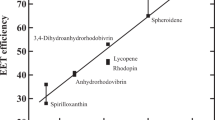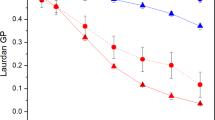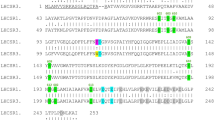Abstract
IT has been shown by several workers that the carotenes of photosynthetic bacteria protect the organisms against a lethel photodynamic reaction in which intracellular bacteriochlorophyll is the photosensitizer1,2. It has been suggested that the carotenes found in many non-photosynthetic bacteria may have the same protective function in these organisms1. Here, some other compound would be the photosensitizer in place of bacteriochlorophyll.
This is a preview of subscription content, access via your institution
Access options
Subscribe to this journal
Receive 51 print issues and online access
$199.00 per year
only $3.90 per issue
Buy this article
- Purchase on Springer Link
- Instant access to full article PDF
Prices may be subject to local taxes which are calculated during checkout
Similar content being viewed by others
References
Stanier, R. Y., and Cohen-Bazire, G., ‘Microbial Ecology’, 56 (Camb. Univ. Press, 1957).
Cohen-Bazire, G., and Stanier, R. Y., Nature, 181, 250 (1958).
Kunisawa, R., and Stanier, R. Y., Arch. Mikrobiol., 31, 146 (1958).
Romig, W. R., and Wyss, O., J. Bact., 74, 386 (1957).
Zobell, C. E., and Feltham, C. B., Bull. Scripps Inst. Oceanography, Tech. Ser., 3, 279 (1934).
Goodwin, T. W., ‘The Comparative Biochemistry of the Carotenoids’ (Chapman and Hall, London, 1952).
Author information
Authors and Affiliations
Rights and permissions
About this article
Cite this article
MATHEWS, M., SISTROM, W. Function of Carotenoid Pigments in Non-Photosynthetic Bacteria. Nature 184, 1892–1893 (1959). https://doi.org/10.1038/1841892a0
Issue Date:
DOI: https://doi.org/10.1038/1841892a0
This article is cited by
-
In vivo creation of plasmid pCRT01 and its use for the construction of carotenoid-producing Paracoccus spp. strains that grow efficiently on industrial wastes
Microbial Cell Factories (2020)
-
Pigments in an iridescent bacterium, Cellulophaga fucicola, isolated from Antarctica
Antonie van Leeuwenhoek (2019)
-
Chemical Characterization and Biotechnological Applicability of Pigments Isolated from Antarctic Bacteria
Marine Biotechnology (2019)
Comments
By submitting a comment you agree to abide by our Terms and Community Guidelines. If you find something abusive or that does not comply with our terms or guidelines please flag it as inappropriate.



